The Visual Electrophysiology Market is estimated to be valued at USD 268.0 billion in 2025 and is projected to reach USD 527.2 billion by 2035, registering a compound annual growth rate (CAGR) of 7.0% over the forecast period.
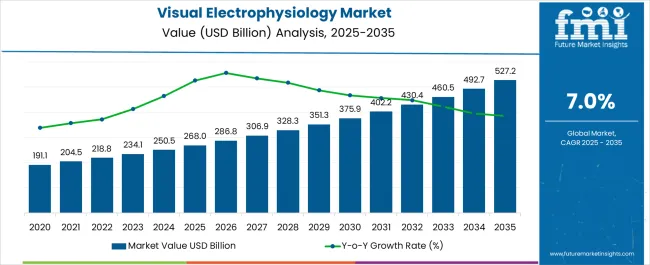
| Metric | Value |
|---|---|
| Visual Electrophysiology Market Estimated Value in (2025 E) | USD 268.0 billion |
| Visual Electrophysiology Market Forecast Value in (2035 F) | USD 527.2 billion |
| Forecast CAGR (2025 to 2035) | 7.0% |
The visual electrophysiology market is expanding steadily as ophthalmic diagnostics advance and awareness around early detection of retinal and optic nerve disorders increases. The rising prevalence of age related macular degeneration, glaucoma, and diabetic retinopathy is driving the need for accurate and non invasive diagnostic tools.
Continuous improvements in signal processing, digital platforms, and user friendly systems are enhancing the clinical adoption of these tests. Increased investment in ophthalmology infrastructure and integration of advanced diagnostic modalities into hospital and specialty clinic workflows are further strengthening demand.
Regulatory emphasis on early screening and preventive care in vision health programs across developed and emerging regions is also contributing to growth. The outlook remains strong as healthcare systems prioritize early intervention and the use of electrophysiology tests to improve treatment outcomes and preserve visual health.
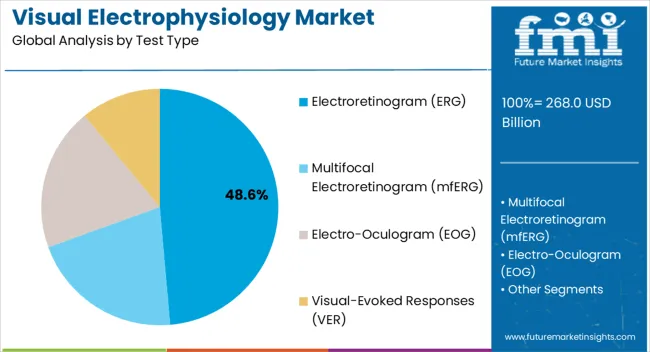
The electroretinogram segment is expected to hold 48.60% of the total market by 2025 within the test type category, making it the leading segment. This dominance is attributed to its ability to provide detailed functional assessment of retinal activity, supporting the diagnosis of a wide range of inherited and acquired retinal disorders.
The growing demand for early detection of retinal diseases, particularly those related to aging populations and metabolic conditions, has reinforced the use of ERG. Continuous advancements in portable and handheld devices have expanded its applicability across hospital and specialty care settings.
As precision in diagnosis becomes increasingly critical, ERG continues to be the preferred modality within test types.
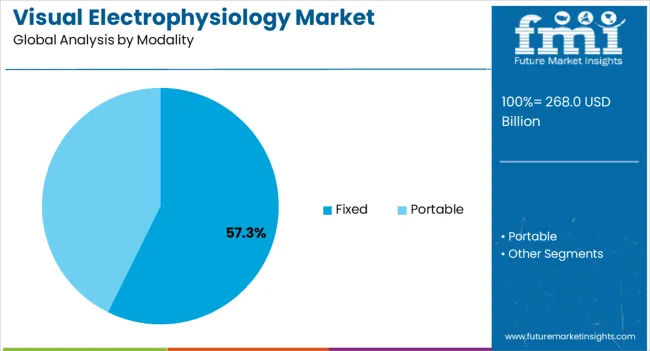
The fixed modality segment is projected to account for 57.30% of total market revenue by 2025, positioning it as the dominant modality. Its strong market position is supported by the reliability, accuracy, and advanced imaging capabilities offered by fixed systems.
These platforms enable comprehensive testing and integration with hospital based diagnostic workflows, making them essential in specialized ophthalmology centers. Their capacity to deliver consistent results with higher patient throughput has further strengthened adoption.
Hospitals and clinics prefer fixed systems due to their robustness and ability to handle complex diagnostic requirements, establishing this modality as the leading choice in the market.
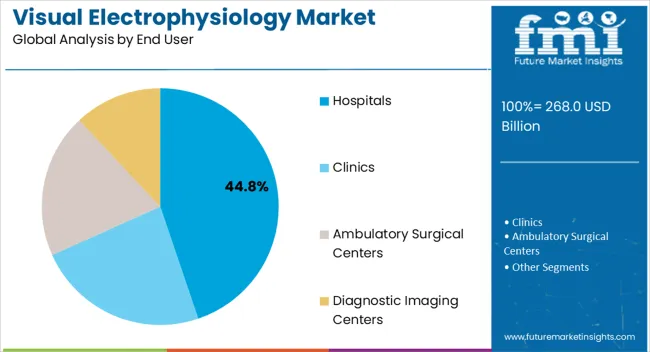
The hospitals segment is expected to represent 44.80% of overall market revenue by 2025 within the end user category, making it the largest segment. This is driven by the availability of advanced diagnostic infrastructure, skilled personnel, and higher patient volumes in hospital settings.
Hospitals serve as the primary centers for complex ophthalmic diagnostics, and their integration of electrophysiology testing into comprehensive eye care programs has accelerated adoption. Additionally, hospitals are often the first point of care for patients with systemic diseases that affect vision, further reinforcing the use of visual electrophysiology tests.
Their ability to combine advanced diagnostics with treatment facilities has solidified hospitals as the leading end user segment in this market.
Rising technological developments and increasing investments in visual electrophysiology devices are expected to boost market growth. Furthermore, the increasing geriatric population in various parts of the world surges the demand for visual electrophysiology.
Rising expenditures in healthcare advancements and growing adoption practice for visual electrophysiology diagnosis are likely to expand the market size. Moreover, the rising prevalence of neurological and eye disorders are key factors that drive the market growth.
Influx funding for research studies, government initiatives, and awareness programs are growing awareness of the benefits of visual electrophysiology. Additionally, using an electroretinogram (ERG) to eliminate any ophthalmic diseases and establishing correct diagnoses are likely to drive the visual electrophysiology adoption trends.
High costs associated with the diagnosis and treatment procedures, along with the lack of experience in using advanced technologies, pose a threat to this market. Moreover, rigid regulations by the government for recording electrical signals in the electrophysiological test are further expected to hinder market growth.
The absence of skilled professionals and the availability of property healthcare infrastructure in developing economies might hamper the visual electrophysiology market.
Growing awareness about the adverse effects of visual and neurological disorders is likely to generate revenue opportunities for the market. Furthermore, increasing research and development (R&D) activities, and technological developments, are expected to accelerate market growth.
Modernization in healthcare devices creates significant opportunities for the market. Additionally, the increasing funding by various governments worldwide is expected to provide growth opportunities. It is important to note that authorities across the world are conducting awareness programs regarding such kinds of tests. This is expected to change the visual electrophysiology market outlook.
| Countries | Revenue Share % (2025) |
|---|---|
| The United States | 33.4% |
| Germany | 5.3% |
| Japan | 3.9% |
| North America | 36.1% |
| Europe | 25.9% |
North America holds a notable share of the visual electrophysiology market with a significant revenue of 33%. During the forecast period, the market share is anticipated to expand. This is because of the increasing investments being made in research and development in the region.
There have been increasing cases of eye-related disorders in the region, which is expected to surge the market growth of visual electrophysiology further. Moreover, the ability to be used across age groups is expected to drive this market.
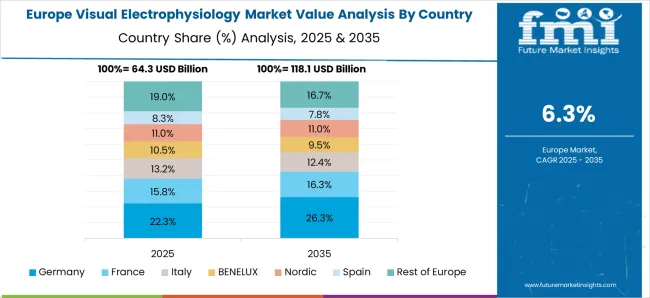
Europe’s visual electrophysiology market held a market share of 25.9% in 2025. Increasing cases of cancer in the region are expected to fuel the growth of the market. Moreover, the rapid advancements in technology are expected to further the rise of this market.
The government in this region is proactive when it comes to dealing with the physical well-being of the population. Therefore, awareness programs are expected to shape the visual electrophysiology market trends in the region.
Asia Pacific is a growing visual electrophysiology market. Improvement of healthcare facilities and economic conditions are likely to surge the market growth.
Japan is also likely to hold a significant market share, owing to the presence of a technologically developed structure. The growing awareness about the importance of eye health is anticipated to bolster the visual electrophysiology market share, in this region. In Asia Pacific as well, increasing investments are being made in research and development, which is expected to drive the market.
| Category | By Test Type |
|---|---|
| Leading Segment | Electroretinogram (ERG) |
| Market Share% (2025) | 38.80% |
| Category | By Modality |
|---|---|
| Leading Segment | Fixed |
| Market Share% (2025) | 65.90% |
Based on test type, the electroretinogram segment leads the market as it held a market share of 38.80% in 2025. On the other side, the modality category is led by the fixed type segment due to the high consumption. The segment held a market share of 65.90% in 2025.
The ability to locate problems at the early stage and to eliminate specific conditions are increasing the popularity of visual electrophysiology. The startups are offering training to cover recent information on new technology, materials, and techniques for innovative practice solutions. Moreover, certain start-up companies are using traditional methods combined with substantial research and development (R&D) activities. For example,
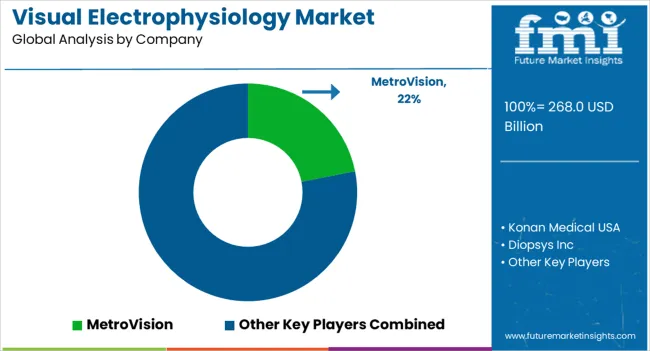
How is the Competitive Landscape in the Visual Electrophysiology Market?
The extensive range of applications including diagnosis, elimination of specific conditions, locating problems at some level of the visual system, etc. is driving key players to improve devices for visual electrophysiology. This is done through research and development (R&D) activities, for clinical and research purposes.
Recent Developments
The global visual electrophysiology market is estimated to be valued at USD 268.0 billion in 2025.
The market size for the visual electrophysiology market is projected to reach USD 527.2 billion by 2035.
The visual electrophysiology market is expected to grow at a 7.0% CAGR between 2025 and 2035.
The key product types in visual electrophysiology market are electroretinogram (erg), multifocal electroretinogram (mferg), electro-oculogram (eog) and visual-evoked responses (ver).
In terms of modality, fixed segment to command 57.3% share in the visual electrophysiology market in 2025.






Full Research Suite comprises of:
Market outlook & trends analysis
Interviews & case studies
Strategic recommendations
Vendor profiles & capabilities analysis
5-year forecasts
8 regions and 60+ country-level data splits
Market segment data splits
12 months of continuous data updates
DELIVERED AS:
PDF EXCEL ONLINE
Visual Analytics Market Size and Share Forecast Outlook 2025 to 2035
Visual Computing Market Size and Share Forecast Outlook 2025 to 2035
Visualiser Market Size and Share Forecast Outlook 2025 to 2035
Pure Visual Perception Solution Market Size and Share Forecast Outlook 2025 to 2035
Surgical Visualization Market
Endoscopy Visualization Systems Market Size and Share Forecast Outlook 2025 to 2035
Endoscopy Visualization System And Component Market Analysis – Trends & Forecast 2024-2034
Logistics Visualization System Market
Arthroscopy Visualization Systems Market Size and Share Forecast Outlook 2025 to 2035
Audible and Visual Signaling Devices Market Analysis by Product Type, End-Use Industry, and Region through 2035
Advanced (3D/4D) Visualization Systems Market Analysis by Platform, End User, Application, and Region through 2035
Electrophysiology Equipment and Recording Systems Market Size and Share Forecast Outlook 2025 to 2035
Electrophysiology Market Analysis - Size, Share, and Forecast Outlook 2025 to 2035

Thank you!
You will receive an email from our Business Development Manager. Please be sure to check your SPAM/JUNK folder too.
Chat With
MaRIA